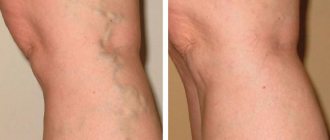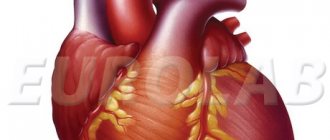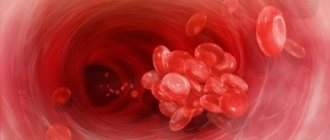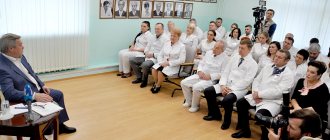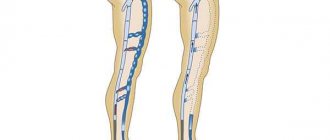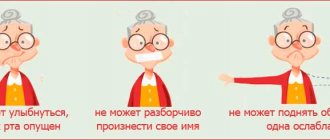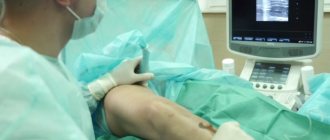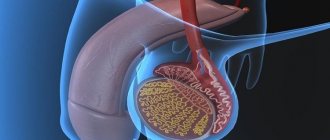Varicose veins of the lower extremities are the most common vascular pathology. Its spread is explained by the modern sedentary lifestyle. Bad habits, excess weight, sedentary work and hereditary predisposition are the main factors in the development of varicose veins. Modern medicine offers an effective solution to this problem. Thanks to phlebectomy - surgery on the veins of the legs - it is possible to completely get rid of the symptoms of the disease, restore blood circulation in the lower extremities and return to a normal lifestyle.
Phlebectomy (venectomy) is an operation to remove varicose veins, which is performed in cases where other methods of treating varicose veins have proven ineffective. The main goal of this method is to normalize blood flow, as well as reduce the risk of developing thrombosis, bleeding and trophic ulcers in patients with advanced stages of varicose veins. Phlebectomy is safe and effective.
Combined phlebectomy is the most common surgical method for treating varicose veins. It involves the removal of pathologically altered veins using special instruments and a variety of surgical techniques. During the operation, only the saphenous veins are removed, which do not disrupt the functioning of the human circulatory system.
You can undergo modern diagnostics and innovative treatment for varicose veins of the lower extremities at the Yusupov Hospital, where a full range of phlebological services is provided. Phlebologists at the Yusupov Hospital are fluent in all modern methods of eliminating varicose veins.
How relevant, in your opinion, is surgical treatment of varicose veins today?
Phlebectomy, of course, is relevant, if only because we often encounter advanced forms of varicose veins: people do not always see a doctor on time. This is the first point. Second, surgery is necessary if the patient has certain characteristics of the veins, for example, they are very wide or very tortuous. Then it will not be possible to cure varicose veins using any other methods: neither sclerotherapy nor laser will guarantee that the lumen of the vein is completely closed.
The third important point when we can recommend surgery is a large number of lateral tributaries near the main vein. They can be removed using minimally invasive methods, but this takes a lot of time, which is difficult for the patient. It is in his interests to agree to the operation.
Description of the disease
Varicose veins in the legs are a common disease in which gross changes in the walls of the veins occur and the development of functional insufficiency of the valve apparatus. As a result, a circulatory disorder occurs, which is accompanied by corresponding clinical symptoms.
Women are more likely to develop CVD than men. This is due to cyclical changes in the concentration of hormones in the body. Due to this, the elasticity of the vein walls increases and the valve apparatus loosens. Among the main causes of varicose veins of the lower extremities are:
- hereditary predisposition;
- prolonged standing or sitting;
- lack of physical activity;
- regular weight lifting;
- long-term use of estrogen-containing drugs;
- age over 30 years.
Symptoms of varicose veins in the legs are heaviness, a feeling of fullness, itching or burning. An aching, pulling, throbbing pain appears in the lower extremities. The most typical localization of pain is the calf muscles. Symptoms of varicose veins worsen after standing for a long time. A decrease in the severity of clinical signs is observed when walking, lying horizontally, and wearing compression garments. Depending on the severity of the condition, cramps may occur at night.
When examining the lower extremities, visible tortuous veins of a bluish color are determined. Many people mistakenly mistake spider veins for the initial manifestations of varicose veins of the lower extremities. This symptom is characteristic of various vascular pathologies. Therefore, when a clinical sign appears, it is recommended to consult a doctor to make a correct diagnosis.
If you do not seek medical help in a timely manner, the course of varicose veins becomes severe. As a result of prolonged circulatory disturbances, trophic changes occur in the affected area. Early signs of ulcer development are hyperpigmented areas. Next, the pathological process spreads to the subcutaneous fat. Compacted areas appear. In addition to the formation of trophic ulcers, severe swelling of the lower extremities occurs. The appearance of the above symptoms requires consulting a doctor. Specialists at the Yusupov Hospital carry out all types of diagnosis and treatment of varicose veins and its complications. For this purpose, the latest equipment and modern materials are used.
Make an appointment
How is phlebectomy performed?
Each operation has several stages. Crossectomy is a step where the target vein that we remove is ligated and thereby cut off from the deep venous system. Next comes the removal of the trunk - stripping. This can be a Babcock stripping, when the vein is cut out using a special probe. Cryostripping can be performed - an operation in which a cryoprobe is inserted into a vein, the vessel is “frozen” to it using nitrous oxide, and the doctor pulls it out. A distinctive feature of cryostripping is that the patient makes only one incision in the groin area. PIN stripping can also be performed, when the vein is “screwed” inward. The last two methods cause less tissue damage.
At the third stage, a miniphlebectomy is performed - the tributaries of the main vein are removed through punctures.
Preparing for surgery
Before surgery, you will need to undergo a standard clinical minimum of diagnostic tests:
- General blood and urine analysis;
- Blood chemistry;
- Tests for RW, hepatitis B and C, HIV;
- Coagulogram; ECG;
- Fluorography.
You will have to choose compression hosiery for yourself in advance on the recommendation of your treating phlebologist. Immediately before the operation, you should shave the hairs at the site of the manipulation. If general anesthesia is expected, you should not eat or drink on the day of surgery. In the evening you should perform a cleansing enema.
How long does the recovery period last?
Usually a week. We recommend that patients stay at home, but not in bed, but semi-active. The first three days you can spend about 40% of the time on your feet, and then you need to start “pacing.” On the seventh day, the stitches are removed and the sick leave is closed. For example, we had a patient who had surgery on both legs in turn. And once he completely went through the recovery period, and the second time he had to go to a work meeting after the operation. This leg recovered worse; there were bruises, although he tried to spare the leg and not put stress on it.
Without hospitalization and sick leave
When treating varicose veins in our clinic, hospitalization is not necessary. Complex cases of varicose veins are treated by combining laser coagulation and miniphlebotomy. Minimal trauma, as well as a low risk of intervention, allow this operation to be performed in a day hospital. After modern miniphlebectomy, the patient can be sent home half an hour after the intervention. In the postoperative period, you need to lead an active lifestyle, active walking is encouraged. Temporary incapacity for work usually lasts no more than 7 days, then it is possible to begin work.
And the last question - what happens if surgery is indicated, but the person does not do it?
I usually say this: “If you don’t deal with the disease, then the disease will deal with you.” If phlebectomy is not performed, varicose veins can lead to thrombophlebitis, and then the veins will have to be removed urgently. Therefore, I recommend that if there are indications for surgery, calmly collect all the tests, prepare and perform it.
Phlebectomy cost:
The main goal of the Phlebology Center clinic is to ensure maximum safety for the patient during surgical treatment. All operations are performed under local anesthesia by surgeons with at least 5 years of experience and only in the presence of an experienced anesthesiologist.
The cost of surgical treatment includes: hospital stay, anesthesia, postoperative dressings, suture removal. After completing the course of treatment, you will receive free six-month observation with ultrasound control.
Indications
The main indications for phlebectomy of the veins of the lower extremities include:
- Varicose veins. This is the most common reason for phlebectomy. The pathology affects the subcutaneous and deep veins and contributes to circulatory disorders. In the initial stages, it is possible to use medications. In more severe stages of the disease, surgery is prescribed.
- Thrombophlebitis of superficial veins. The operation is performed for acute or chronic forms of pathology. The disease leads to the lumen of the vessel being blocked by the resulting clot. As a result, an obstruction occurs in the path of blood flow with subsequent circulatory disorders. In cases where medications do not help resolve the clot, surgical intervention is performed.
- Trophic ulcers. The disease can affect the skin and soft tissues. An indication for emergency vein removal surgery is the occurrence of heavy bleeding from the affected areas.
- Venous insufficiency. Pathologically, the process affects the valves of blood vessels. As a result, there is a disruption in the outflow of blood, which leads to stagnation. Phlebectomy is the most appropriate surgical option for this condition.
Regimen and restrictions after the RFA procedure (radiofrequency obliteration (ablation) procedure) or EVLT (endovascular laser coagulation) . Advice from an experienced patient - I underwent radiofrequency surgery (EVLT), how to behave and what to do after the operation. The patient's regimen and possible restrictions after endovascular (intravascular) surgery.
After RFA or EVLT procedure:
Having received recommendations and a statement from the doctor about the manipulation performed (RFA or EVD) on varicose veins, you can safely go home. A walk lasting 1 hour, while you can calmly lean on the operated leg, there is no need to limp or “take care” of the leg (the leg doesn’t hurt!). Walk with a normal gait to your home, to your destination. After the procedure, the motor mode is normal; I do not recommend jumping, running or lifting weights for a month. You can lie down, sit.
You can get up and walk, but without fanaticism.
If you are traveling in a car or bus, periodically, every 20-30 minutes, you should perform short exercises, bending and straightening your feet. When you stop (for example, after 1 hour), get up and walk around calmly, warm up carefully.
The compression stocking should not be removed until the time (before examination) prescribed by the operating doctor.
You should come for a consultation at the appointed time. The doctor will conduct a control ultrasound and change the bandages. There is no need to change the dressings every day - you “touch” less and it heals better.
In the evening in bed, before going to bed, you can remove the compression stocking (without removing the “internal” bandages), wipe your leg with wet wipes or a towel, and then put on the compression stocking. Exposed parts of the operated limb, with increased dryness, can be treated with moisturizing cream (must be completely absorbed before putting on the stocking).
You cannot stand or walk without compression; for how long is determined by your operating doctor (usually from 7 to 30 days). You can remove the compression stocking for 10-15 minutes while sitting on the sofa or in bed with your leg in a horizontal position. Temporarily change physical education to chess combined with walking.
The doctor allowed you to remove the bandages yourself; you need to remove them in the evening before going to bed. If ichor comes out through the punctures, treat them with a 5% solution of boric alcohol. After treatment, let the punctures “dry” and go to sleep quietly. It is better to start water procedures after the punctures have completely healed (the crust should fall off), otherwise the scar at the puncture site will be rougher.
Treat punctures only with an alcohol solution (the best is 5% boric alcohol). Do not use aqueous solutions - miramistin, chlorhexedine, peroxide, etc.
What medications should I take after RFA (radiofrequency obliteration (ablation) procedure) or EVLT (endovascular laser coagulation) procedure?
For pain, anti-inflammatory drugs:
Ortofen 25 (50) mg 2 times a day, after meals, with a small amount of water, course 5 - 7 days.
Antibiotics are rarely prescribed. If necessary, the operating doctor will definitely prescribe it.
Medicines for veins - antistax, venarus or phlebopa, are also usually prescribed by your doctor. The course is usually from 2 weeks to 2 months.
How long should I wear compression stockings after the procedure when I can walk without stockings?
For the first 3-5 days, you should wear compression stockings day and night. It is possible to remove the jersey before going to bed (with the legs in a horizontal position), wipe the legs with a damp towel or napkins, and moisturizer if necessary.
In advanced stages, if there were ulcers, swelling, or skin pigmentation before the procedure, the compression should be worn longer - up to several months. Perhaps in such cases, UHF No. 10 is applied to “painful” areas (the operating doctor will indicate).
Water procedures - the ichor has stopped oozing and the crusts have fallen off (the punctures have healed), wash for good health. However, if discharge through punctures persists, treat these areas with 5% boric alcohol and temporarily refrain from showering (you can wash in parts, only carefully - the bath is a danger zone).
When can you play sports?
Athletic exercises (running, race walking, exercise bike) are possible 15 days after the RFA (radiofrequency obliteration (ablation) procedure) or EVLT (endovascular laser coagulation) procedure.
Optimally - medi sports compression stockings (your surgical compression stocking will also work).
You can go to the pool 15 days after the procedure.
Baths or saunas are possible 1 - 3 months after the RFA procedure (radiofrequency obliteration (ablation) procedure) or EVLT (endovascular laser coagulation).
Have questions? Call: +7 342 204-78-88
